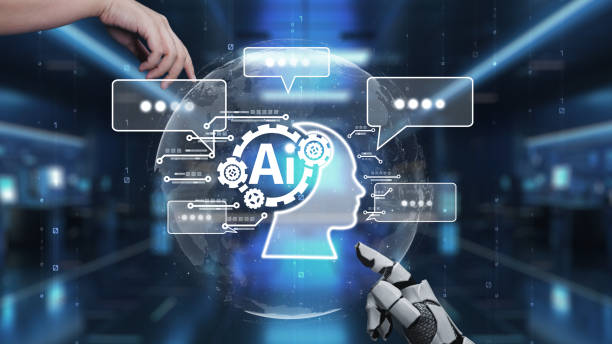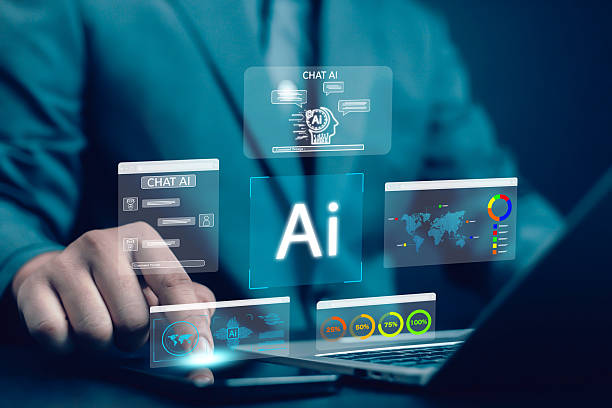What is an AI Robot and How Does it Work?

An #Artificial_Intelligence_Robot (AI Robot) is a combination of two distinct fields: #Artificial_Intelligence (AI) and #Robotics.
Simply put, an AI robot is a physical or virtual machine capable of performing tasks that typically require human intelligence, powered by artificial intelligence algorithms.
These tasks include learning, problem-solving, natural language understanding, pattern recognition, and decision-making.
Artificial intelligence enables the robot to interact with its surroundings, process information, and adjust its behavior based on this information.
How an AI Robot Works:
- 1. Sensors: Robots use various sensors to receive information from the environment.
These sensors can include cameras, microphones, touch sensors, temperature sensors, proximity sensors, and more. - 2. Information Processing: The information received by sensors is sent to the robot’s Central Processing Unit (CPU).
In this unit, artificial intelligence algorithms are employed to analyze and interpret the data.
These algorithms can include neural networks, machine learning algorithms, search algorithms, and more. - 3. Decision-Making: Based on the analysis of information, the robot decides what action to take.
This decision-making can be based on a pre-programmed plan or on the robot’s learning and experience. - 4. Actuation: After making a decision, the robot uses actuators to perform the desired action.
Actuators can include motors, arms, wheels, speakers, and more.
Examples of AI Robots:
- Industrial Robots: Used for repetitive and dangerous tasks in factories.
- Self-Driving Cars: Capable of driving without human intervention using AI.
- Service Robots: Used to provide various services such as cleaning, product delivery, and elderly care.
- Military Robots: Used for dangerous and high-risk tasks on the battlefield.
In summary, AI robots are powerful tools that can assist humans in many fields.
With technological advancements, we expect to see an increased application of AI robots in our daily lives.
It appears that artificial intelligence, and especially AI robots, will have a profound impact on human life.
Does your current website convert visitors into customers or drive them away? Solve this problem forever with professional corporate website design by Rasawweb!
✅ Build strong credibility and branding
✅ Attract target customers and increase sales
⚡ Get a free consultation now!
Types of AI Robots Based on Application and Structure
![]()
AI robots can be categorized based on various criteria.
In this section, we will explore types of robots based on their application and structure:
Categorization by Application:
- Industrial Robots: These robots are used in factories and production lines for repetitive, heavy, and dangerous tasks.
AI robots in this category typically have high precision and speed, and can work continuously without fatigue. - Service Robots: These robots are designed to provide various services to humans.
Examples of service robots include cleaning robots, delivery robots, eldercare robots, and educational robots. - Medical Robots: These robots are used in the medical field for precise surgeries, assisting in patient rehabilitation, and providing remote medical services.
- Military Robots: These robots are used in the military for dangerous and high-risk tasks such as bomb disposal, target identification, and reconnaissance operations.
- Space Robots: These robots are used for space exploration, satellite repair, and conducting scientific research in harsh space conditions.
- Household Robots: These robots are designed to perform daily tasks at home.
Examples include smart vacuum cleaners.
Categorization by Structure:
- Articulated Robots: These robots have multiple joints that allow them to move in various directions.
Industrial robots are typically of this type. - Cylindrical Robots: These robots have a cylindrical axis around which they rotate.
- Spherical Robots: These robots have a spherical joint that allows them to move at various angles.
- Delta Robots: These robots have a parallel structure that allows for fast and precise movement.
- Mobile Robots: These robots are capable of moving in the environment and typically have wheels or legs.
Choosing the appropriate type of AI robot depends on the intended application and its specific needs.
With technological advancements, we anticipate the emergence of smarter robots with more capabilities.
AI robots can make human life easier.
Main Components of an AI Robot: Hardware and Software Review

An AI robot consists of two main parts: hardware and software.
These two components work together to enable the robot to perform various tasks.
Hardware:
- Sensors: Sensors collect information from the surrounding environment.
This information can include visual data (cameras), audio (microphones), tactile (touch sensors), temperature, pressure, and more. - Actuators: Actuators control the robot’s movements.
These actuators can include motors, arms, wheels, and more. - Controller: The controller is the robot’s brain, responsible for processing information and controlling the actuators’ performance.
The controller is usually a small computer or a microcontroller. - Power Source: The power source provides the necessary energy for the robot’s operation.
This source can include batteries, solar cells, and more.
Software:
- Operating System: The operating system is responsible for managing the robot’s hardware resources.
- AI Algorithms: Artificial intelligence algorithms are responsible for information processing, learning, decision-making, and planning.
These algorithms can include neural networks, machine learning algorithms, search algorithms, and more. - Robot Control Software: This software is responsible for controlling the robot’s movement and operation.
- User Interface Software: This software allows the user to interact with the robot.
Table 1: Comparison of Sensors and Actuators
| Feature | Sensors | Actuators |
|---|---|---|
| Function | Gathering information from the environment | Controlling robot movements |
| Types | Cameras, microphones, touch sensors | Motors, arms, wheels |
| Output | Raw data | Movement |
These two parts, hardware and software, work together to enable the AI robot to perform various tasks.
As you know, robotics is the science of designing robots.
Machine Learning and Its Role in the Development of Intelligent Robots
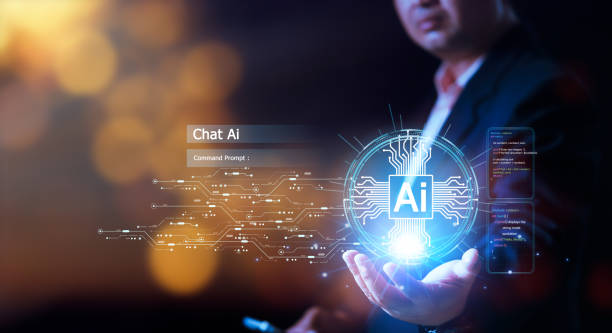
#Machine_Learning is a subfield of #Artificial_Intelligence that enables machines to learn from data without explicit programming.
This learning occurs through various algorithms that allow machines to recognize patterns in data and make decisions based on them.
The Role of Machine Learning in the Development of Intelligent Robots:
Machine learning plays a very important role in the development of intelligent robots.
By utilizing machine learning algorithms, robots can:
- Adapt to their surroundings: Robots can analyze sensor data, identify patterns in the environment, and adjust their behaviors accordingly.
- Perform complex tasks: By learning from training data, robots can perform tasks that are difficult or impossible to explicitly program.
- Continuously improve: Robots can enhance their performance over time by learning from their experiences.
Types of Machine Learning Algorithms Used in Robotics:
- Supervised Learning: In this type of learning, the robot is trained using labeled data.
For instance, a robot can learn to recognize different objects using labeled images. - Unsupervised Learning: In this type of learning, the robot is trained using unlabeled data.
For instance, a robot can identify hidden patterns in the environment by analyzing sensor data. - Reinforcement Learning: In this type of learning, the robot is trained by interacting with the environment and receiving feedback (rewards or penalties).
For instance, a robot can learn how to navigate a path through trial and error.
With the advancement of machine learning algorithms, we anticipate the emergence of smarter robots with more capabilities.
These robots can assist humans in various fields such as industry, medicine, services, and more.
An AI robot equipped with machine learning algorithms can improve its performance over time.
Is your e-commerce site ready to maximize customer attraction and increase sales? Rasawweb transforms your online business with modern and efficient e-commerce website designs.
✅ Increased speed and improved SEO
✅ Excellent user experience on mobile and desktop⚡ Get a free e-commerce website design consultation from Rasawweb!
Applications of AI Robots in Various Industries

Due to their unique capabilities, AI robots have extensive applications in various industries.
In this section, we will explore some of these applications:
Manufacturing Industry:
- Production Line Automation: Robots can perform repetitive and dangerous tasks on production lines, leading to increased productivity and reduced costs.
- Quality Control: Robots can accurately inspect product quality using advanced cameras and sensors, preventing errors.
- Packaging and Transportation: Robots can package and transport products to the desired location, leading to reduced labor requirements and increased operational speed.
Medicine:
- Surgery: Robots can assist surgeons in precise and minimally invasive surgeries.
- Rehabilitation: Robots can help patients with rehabilitation exercises.
- Drug Delivery: Robots can deliver medication to patients accurately and on time.
Services:
- Cleaning: Robots can assist in cleaning homes and buildings.
- Product Delivery: Robots can deliver goods to customers.
- Elderly Care: Robots can assist the elderly with daily tasks.
Agriculture:
- Planting and Harvesting: Robots can plant seeds and harvest crops.
- Irrigation: Robots can irrigate plants accurately and efficiently.
- Pest Control: Robots can spray plants accurately and efficiently.
Table 2: Applications of AI Robots in Various Industries
| Industry | Applications |
|---|---|
| Manufacturing | Production line automation, quality control, packaging and transportation |
| Medicine | Surgery, rehabilitation, drug delivery |
| Services | Cleaning, product delivery, elderly care |
| Agriculture | Planting and harvesting, irrigation, pest control |
These are just a few examples of the applications of AI robots in various industries.
With technological advancements, we expect to see more applications of these robots in our daily lives.
AI robots will become an essential tool in various industries.
Artificial intelligence plays a very important role in different fields.
Advantages and Disadvantages of Using AI Robots
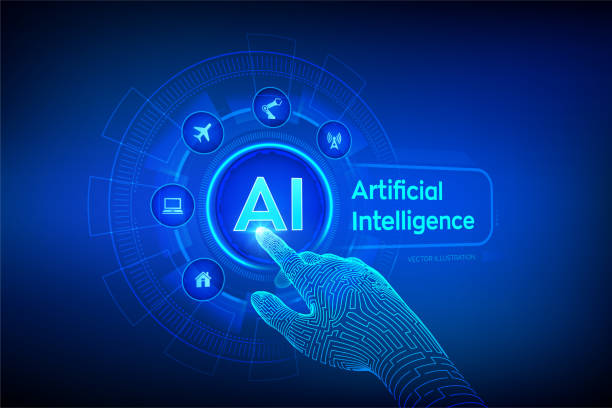
The use of AI robots comes with numerous advantages and disadvantages, which we will explore in this section:
Advantages:
- Increased Productivity: Robots can perform tasks faster and more accurately than humans, leading to increased productivity.
- Cost Reduction: Robots can replace human labor, leading to reduced labor costs.
- Improved Safety: Robots can perform dangerous tasks, leading to improved workplace safety.
- Increased Quality: Robots can perform tasks uniformly and without errors, leading to improved quality of products and services.
- Performance of Difficult Tasks: Robots can perform tasks that are difficult or impossible for humans.
Disadvantages:
- High Initial Cost: Purchasing and installing robots can be expensive.
- Need for Expertise: Setting up, maintaining, and repairing robots requires specialized expertise.
- Job Displacement: The use of robots can lead to job loss for humans.
- Ethical Issues: The use of robots in some areas can raise ethical concerns.
- Technological Dependence: Over-reliance on robots can create problems in case of technical malfunctions.
Considering the advantages and disadvantages of using AI robots, one can decide whether their use is appropriate in a specific field.
It is worth noting that with technological advancements, many of the disadvantages of AI robots are diminishing.
You should know that the effects of robots on human life will be both positive and negative.
The Future of AI Robots and Predicted Developments
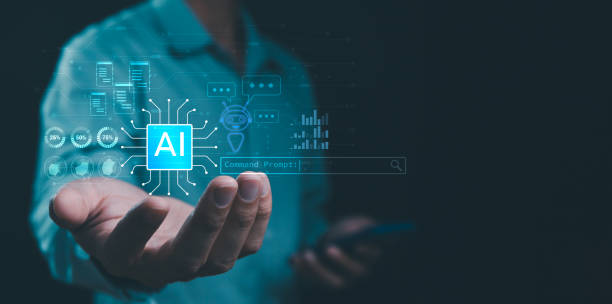
The future of AI robots is very bright and full of developments.
With technological advancements, robots are expected to become smarter, more capable, and more practical.
In this section, we will examine some predictions regarding the future of AI robots:
- Smarter Robots: With advancements in AI algorithms, robots will be able to perform more complex tasks and interact with their surroundings more effectively.
- Increased Use of Robots in Daily Life: Robots are expected to assist humans in various areas such as housework, education, eldercare, and more.
- Greater Human-Robot Collaboration: Robots and humans will work together to perform tasks, leading to increased productivity and an improved quality of life.
- Development of Self-Replicating Robots: Robots capable of reproduction can automatically increase their numbers and be used in areas such as space exploration and construction.
- Emotional Robots: In the future, robots might be developed that can understand human emotions and respond appropriately.
However, the development of AI robots also brings challenges.
Some of these challenges include:
- Ethical Issues: The use of robots in certain areas can raise ethical concerns.
- Security: Robots can be misused, so ensuring their security is crucial.
- Regulation: With the increased use of robots, there is a perceived need for legislation in this field.
Despite the challenges, the future of AI robots is very promising.
With technological advancements and the resolution of existing challenges, robots are expected to play a significant role in human lives.
AI robots will be capable of performing much greater tasks in the future.
With technological advancements, the future of robotics is very promising.
Examining Challenges and Concerns Related to AI Robots
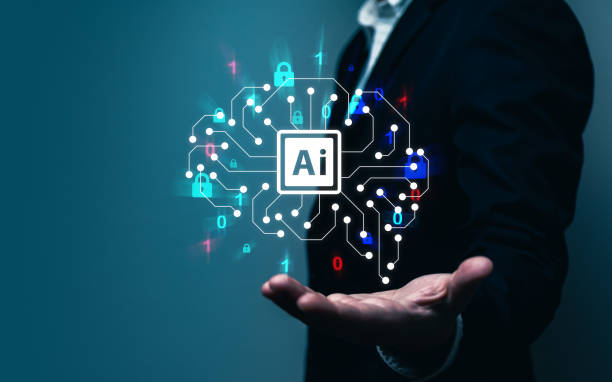
Alongside numerous advantages, the development and use of AI robots also come with challenges and concerns that require careful attention and examination:
- Job Displacement: One of the biggest concerns is the replacement of human labor by robots, leading to job loss for individuals.
This issue requires appropriate planning and policymaking to create new job opportunities and train the workforce for new professions. - Ethical Issues: The use of robots in some areas can raise ethical concerns.
For example, the use of military robots can lead to reduced accountability in wars.
Furthermore, the use of robots in elderly care can lead to reduced human interaction and feelings of loneliness among the elderly. - Security: Robots can be misused.
For example, hackers can hack robots and use them for malicious purposes.
Additionally, robots can accidentally harm humans. - Bias: Artificial intelligence algorithms used in robots can be biased, leading to discrimination against specific groups of people.
- Privacy: Robots can collect a lot of information from humans, which can lead to a violation of individual privacy.
To address these challenges and concerns, there is a need for:
- Developing Appropriate Laws and Regulations: Laws and regulations should be designed to prevent the misuse of robots and protect human rights.
- Developing Fair AI Algorithms: Artificial intelligence algorithms should be designed to be unbiased and not lead to discrimination.
- Ensuring Robot Security: Robots should be designed to be resistant to hacking and misuse.
- Education and Awareness: People need to be aware of the advantages and disadvantages of AI robots to make informed decisions about their use.
Given the importance of these challenges and concerns, further research and investigations are needed in this area to find appropriate solutions.
AI robots should serve humanity and not harm its interests.
Did you know that customers’ first impression of your company is your website? Multiply your business’s credibility with a powerful corporate website from Rasawweb!
✅ Custom and eye-catching design tailored to your brand
✅ Improved user experience and increased customer attraction
⚡ Get a free consultation!
How to Build an AI Robot? A Step-by-Step Guide

Building an AI robot can be a fascinating and challenging project.
In this section, we provide a step-by-step guide to building a simple AI robot:
- 1. Define the Goal: Before starting any work, you must define the purpose of building the robot.
What is your robot supposed to do? This goal can be simple, such as moving along a specific path, or more complex, such as object recognition. - 2. Choose the Hardware: Based on your goal, you need to select the appropriate hardware.
The required hardware includes:- Controller: A small computer or microcontroller that will be the robot’s brain.
- Sensors: Sensors that collect information from the environment.
- Actuators: Actuators that control the robot’s movements.
- Power Source: A battery or another power source that provides the necessary energy for the robot.
- 3. Select the Software: To control the robot and implement AI algorithms, you need suitable software.
Some popular software for building AI robots include:- Arduino IDE: For programming microcontrollers.
- Python: A powerful programming language for implementing AI algorithms.
- TensorFlow: An open-source library for machine learning.
- 4. Program the Robot: After selecting the hardware and software, you should start programming the robot.
This involves writing code to control sensors, actuators, and AI algorithms. - 5. Test and Improve: After completing the programming, you should test your robot and troubleshoot any potential issues.
You can also improve the robot’s performance by collecting data and training AI algorithms.
This guide provides an overview of the steps involved in building an AI robot.
For more information, you can use online resources and training courses.
An AI robot can be built with a little effort.
Robotics training will greatly assist you in this field.
Case Study: Examining a Successful AI Robot

To better understand the applications and potentials of AI robots, this section examines a case study of a successful AI robot.
One prominent example in this field is the intelligent robot ‘Sophia’.
Sophia is a humanoid robot developed by Hanson Robotics.
This robot uses artificial intelligence to interact with humans, answer questions, and display emotions.
Sophia is capable of understanding its surroundings using cameras and microphones, and speaking with humans in various languages using natural language processing algorithms.
Prominent Features of Sophia:
- Human-like Appearance: Sophia has a human-like appearance, which makes interacting with it easier and more natural for humans.
- Ability to Interact with Humans: Sophia is capable of speaking with humans in various languages and answering their questions using natural language processing algorithms.
- Ability to Display Emotions: Sophia can display various emotions such as joy, sadness, surprise, and anger using its face.
- Learning Capability: Sophia can learn new information and expand its knowledge through interaction with humans.
Applications of Sophia:
- Customer Service: Sophia can provide customer service in stores, hotels, and airports.
- Education: Sophia can assist in teaching students in schools and universities.
- Elderly Care: Sophia can provide care for the elderly in homes and nursing facilities.
- Research: Sophia can be used in research related to artificial intelligence and robotics.
Lessons Learned from Sophia:
- A human-like appearance can make interaction with robots easier for humans.
- Natural language processing algorithms can help robots communicate more effectively with humans.
- Robots can assist humans in various fields.
Sophia is a successful example of AI robots, demonstrating that these robots can play a significant role in our daily lives.
The AI robot Sophia has greatly contributed to the advancement of this industry.
Advances in robotics are owed to the efforts of researchers in this field.
Frequently Asked Questions
| Question | Answer |
|---|---|
| What is an AI robot? | It is a robot that uses artificial intelligence capabilities for environmental perception, reasoning, learning, and decision-making to perform complex tasks autonomously. |
| What is the main difference between a regular robot and an AI robot? | AI robots can learn and adapt to their environment, while regular robots typically operate based on fixed, pre-programmed instructions. |
| In what fields are AI robots used? | In fields such as industry (production lines), medicine (robotic surgeries), services (customer support, smart vacuum cleaners), exploration (space and underwater), and entertainment. |
| How do AI robots learn? | They acquire new skills through machine learning and deep learning algorithms, by analyzing large datasets and identifying patterns. |
| Can AI robots have emotions? | Currently, no. They can recognize or simulate emotions, but they do not experience real emotions like humans do. |
| What are the most important advantages of using AI robots? | Increased productivity, reduced human error, performing dangerous or repetitive tasks, and providing innovative and efficient services. |
| What challenges exist in the development of AI robots? | The need for abundant and high-quality data, algorithmic complexity, ethical issues, cybersecurity, and high research and development costs. |
| Are AI robots dangerous to humans? | With adherence to safe design principles and ethical regulations, no. Concerns are mostly related to social and economic impacts, such as changes in the job market. |
| What is an example of an AI robot in daily life? | Smart vacuum cleaner robots (like Roomba) that automatically map and clean homes, or smart voice assistants (like Siri and Alexa). |
| How is the future of AI robots predicted? | They are expected to become smarter, more autonomous, and capable of more complex interaction with humans, playing a more prominent role in industry, medicine, transportation, and daily life. |
And other advertising services by Rasawweb Advertising Agency:
- Smart Custom Software: A fast and efficient solution to increase website traffic, focusing on optimizing key pages.
- Smart Advertising Campaign: Professional optimization to attract customers using SEO-driven content strategy.
- Smart Website Development: A professional solution for online growth, focusing on SEO-driven content strategy.
- Smart Social Media: A combination of creativity and technology for campaign management through attractive UI design.
- Smart Brand Identity: An effective tool for attracting customers with the help of an SEO-driven content strategy.
And over hundreds of other services in the field of internet advertising, advertising consultation, and organizational solutions.
Internet Advertising | Advertising Strategy | Advertorial
Sources
AI Robots and the Future of HumanityComprehensive Guide to AI RobotsImpact of Artificial Intelligence on SocietyLatest Developments in Artificial Intelligence
? Are you ready to transform your business in the digital world? Rasawweb Afarin Digital Marketing Agency, by providing comprehensive services including custom website design, professional SEO, and social media management, paves the way for your growth and success. With us, have a powerful and lasting online presence.
📍 Tehran, Mirdamad Street, Next to Central Bank, Southern Kazeroun Alley, Ramin Alley, No. 6

